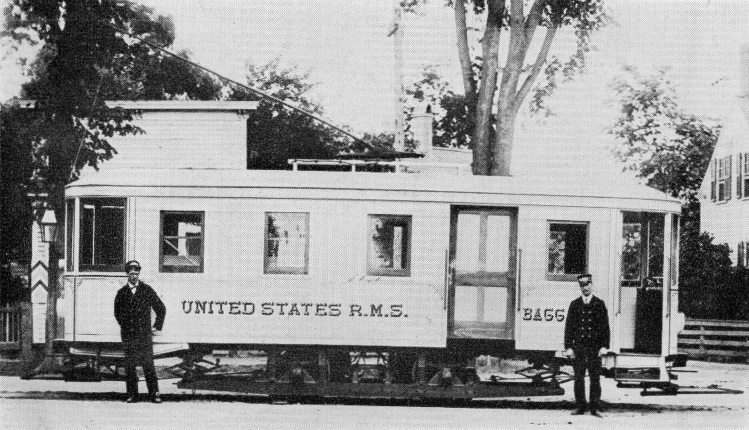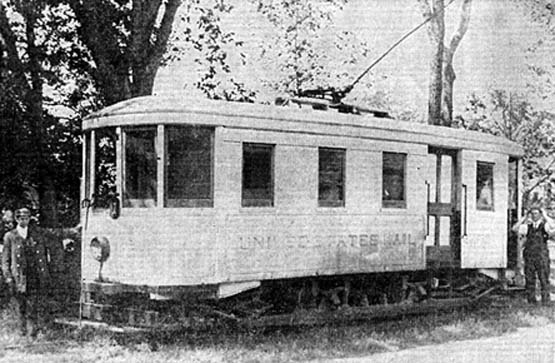Letter Answered Same Day
By O. R. Cummings
The New Hampshire Sunday News, Sunday, January 7, 1973
(NOTE: Mr. Cummings, a copy editor for the Union Leader,
is a trustee of the Seashore Trolley Museum
and a longtime railroad and trolley aficionado.-Ed.)

[Photo from the collection of O. R. Cummings]
Writing a letter, posting it and receiving a reply by mail on the same day is all but impossible in this modern age, but 70 years ago, it not only was possible but also was a regular occurrence in the seacoast area towns of Exeter, Hampton, Hampton Falls and Seabrook – thanks to the Exeter, Hampton & Amesbury Street Railway.
The EH&A’s trolley line between Exeter and Amesbury, Mass., Hampton Village, Hampton Falls and the Smithtown area of Seabrook was completed in the early summer of 1899 and a little later, the street railway was awarded a U.S. Post Office Department contract to carry pouch mail on its regular passenger cars between Exeter and Smithtown.
The agreement called for three round trips daily, Monday through Saturday, between Exeter and Hampton Falls and two round trips daily except Sunday between Exeter and Smithtown. The pouches were to be received at and forwarded from the Hampton depot, where connections were to be made with mail trains on the Boston & Maine Railroad.
Inaugurated Sept. 11, 1899, this new service proved to be only a temporary arrangement for on Feb. 7, 1900, a new contract signed by the Exeter, Hampton & Amesbury and the Post Office Department called for the operation of a railway post office car between Exeter and Amesbury beginning March 1. A four wheel trolley freight car already owned by the railway was altered for mail service, being provided with benches, racks and sorting cases for the use of the mail clerk, and a new combination mail and baggage car was ordered from a car builder in Newburyport, Mass.
Promptly on the advertised date, Thursday, March 1, the former freight car left the Exeter depot at 8 a.m. sharp for the first mail trip to Amesbury. Nicholas Walsh of Amesbury was the motorman; Herbert Pierson of Exeter was the conductor, and H. D. Burlingame was the mail clerk. Aboard on the initial run were Chief Clerk C. E. Marshall of the railway mail service’s Portland, Maine, office and General Manager Albert E. McReel of the street railway. Despite an ice storm, the car made good time and arrived in Amesbury one hour 40 minutes later.
The schedule called for three round trips daily except Sunday and one round trip on holidays. Departures from Amesbury were scheduled for 6:30 and 9:30 a.m. and 1 p.m. and the car was to leave Exeter at 8 and 11:30 a.m. and 4:30 p.m. Stops were made at the Exeter, Hampton, Hampton Falls, Seabrook and Smithtown post offices en route and the car was housed at night at Amesbury.
New Mail Car
Late in June, the new baggage and mail car was delivered to the EH&A and was placed in service on July 1. Numbered 18, it had a 20- foot body, divided by a partition into a mail room and a baggage compartment. The former was equipped with ample pouch racks of steel, a work bench and sorting compartments. The latter had a sliding door on each side. A contemporary newspaper noted that the exterior of the car was painted “a creamy tint” and was trimmed with carmine and gold. On either side, at the top, was “Exeter, Hampton & Amesbury St. Ry. Co.” in gilt letters and below, “United States R.M.S.” and “baggage” in red and gilt. The interior was painted white and the car was heated and lighted by electricity.
The EH&A mail service officially designated the “Exeter & Amesbury RPO” and this postmark was used to cancel stamps on letters and packages picked up along the run. Baggage and small parcels also were handled on the car, these shipments being under the supervision of the conductor.

[Photo from the collection of O. R. Cummings]
At first, the mail car made no scheduled stops between Smithtown and Amesbury but effective July 18, 1900, in accordance with arrangements made by Postmaster Samuel Rowell of Amesbury, the clerk began making deliveries to postal patrons between Amesbury and Smithtown, groups of rural mail boxes being installed at various points. Thus, No. 18 provided rural free delivery as well as RPO service. At about the same time, two mail boxes, one for deliveries and one for collections, were installed beside the trolley tracks on the Exeter side of the Exeter-Hampton boundary. Two similar boxes were provided in Hampton about a half mile east of the town line. Mail was delivered to and collected from these boxes three times daily.
Same Day Service
Under the schedule of the mail car, a letter posted at Smithtown before 10 a.m. would arrive in Exeter at 11. Assuming an early pickup at the post office by the addressee, the reply, if posted before 4:30, would be in Smithtown all hour later. In those years, the post offices in Smithtown, Seabrook and Hampton Falls were located in general stores, the proprietors of which doubled in brass as postmasters, and at scheduled mail arrival times, these stores usually were thronged by those expecting letters or parcels — or just seeking sociability.
There were times, of course, when the mail service was disrupted by weather conditions or other factors, but the Exeter, Hampton & Amesbury always went the extra mile to make certain that No. 18 could make its regular schedule. Every night, while the car was laying over at Amesbury, it was given a thorough mechanical and electrical inspection — preventive maintenance, it would be called today.

[Photo from the collection of O. R. Cummings]
All Good Things
Unfortunately, all good things must come to an end and the Exeter & Amesbury RPO made its last trips on Monday, Jan. 31, 1910. No specific reason for the discontinuance was given by either the railway or the Post Office Department — the service just ended. Thereafter, the EH&A carried pouch mail on its regular passenger cars running between Exeter and Smithtown throughout the year and also between Hampton Village and Hampton Beach from June 1 to Sept. 15 annually.
The railway was penalized financially for missed mail trips and at times when the tracks were blocked by snow and ice and the trolleys couldn’t run, a horse and sleigh were pressed into service to carry the postal matter. Passengers might not have transportation but the mail had to get through!
After the discontinuance of the RPO service, the former mail car was used for several years to carry freight between Exeter and Hampton Beach. Subsequently it saw service as a general utility and salt car. When the street railway was abandoned in 1926, the body of the mail car was sold to a private party and ended its years as a shed on a Hampton farm [on Exeter Road].